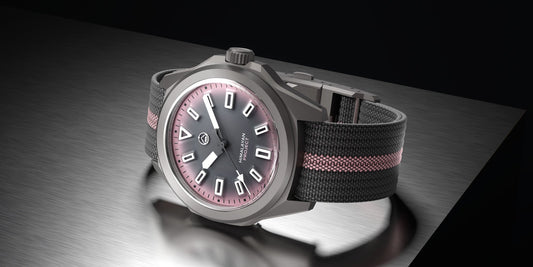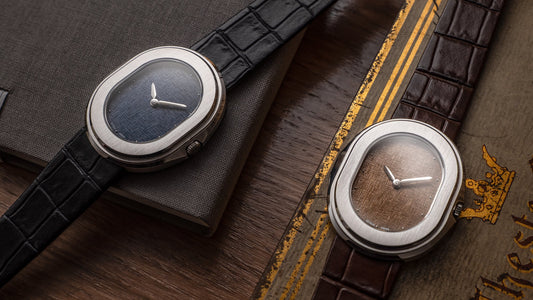Before a few years ago, a typical watch brand’s portfolio would reveal designs predominantly engineered from stainless steel, titanium, gold and maybe even ceramic. Then arrived bronze, a two-thousand-year-old material that took the timepiece industry by storm. With its rustic allure and patina-pending charm, bronze has etched its presence into the contemporary world of wristwatches. Bronze has proven it’s here to stay, but what exactly does that mean for watch wearing?
What is Bronze?
 Maurice Lacroix Pontos S Diver - Credit WatchGecko
Maurice Lacroix Pontos S Diver - Credit WatchGecko
Bronze is a metal alloy primarily composed of copper and tin. The exact composition can vary, but in watchmaking, it typically lies at 7.5-8% tin, 92% copper and around 0.30% phosphorus. The metal has a distinctive warm, reddish-brown, golden colour and is valued for its durability, corrosion resistance and unique ability to develop a patina.
If you’ve been a part of the watch world for some time now, you’ll likely have noticed the increase in bronze watches on the market. While most timepieces are engineered from classic stainless steel or gold, there are several now entirely engineered from bronze – mainly those in the dive watch genre. The material offers a unique set of properties that for many make it a necessity in their watch collection.
What are the advantages of bronze watches?
 Oris - Credit WatchGecko
Oris - Credit WatchGecko
One of the most distinctive features of bronze watches is their ability to develop a natural patina over time. As the metal reacts with oxygen and pH levels in the skin, it forms a thin, protective layer on the surface giving it a distinguishing look. The effect of the patina gives the watch a beautiful, vintage charm that many watch enthusiasts find appealing.
The patina created when wearing your bronze watch is also completely unique to the wearer. The development of the patina is influenced entirely by the wearer’s environment and usage, so the appearance of the watch is ultimately a reflection of its owner and their adventures together. It’s a wonderful sentiment for those that like a personal touch with their timepiece.
As well as being aesthetically appealing with its patina-pending, warm golden hue, bronze is also a robust and resilient watch material. Bronze is widely used to create nautical equipment due to its resistance to seawater which makes it perfectly suitable for engineering dive watches. Its corrosion resistance is also matched by its durability; it’s one of the best watch materials for withstanding everyday wear and tear.
What are the disadvantages of bronze watches?
 Sinn T50 - Credit Sinn
Sinn T50 - Credit Sinn
Depending on your preferences as a watch wearer, some of the advantages of bronze watches may instead be a disadvantage. For example, owning a watch that naturally tarnishes and develops a patina may not suit your typical tastes for a typically polished and pristine look. Bronze is also prone to oxidation and staining. In some instances, bronze can leave behind a green or brown patina which may transfer to your skin and clothes.
Bronze also requires regular maintenance to preserve the patina and prevent excessive oxidation. This may not suit collectors that prefer their timepieces low maintenance. Some individuals may also experience sensitivity to bronze on their skin. Other disadvantages to bronze watches include heaviness, since bronze is denser than other materials in watchmaking like steel and titanium, and price. Bronze watches can come at a premium compared to their steel counterparts due to the exclusivity of the metal in the industry.
How do you keep bronze watches from tarnishing?
 Escudo Chocolate Bronze - Credit WatchGecko
Escudo Chocolate Bronze - Credit WatchGecko
Bronze watches are known for their distinctive patina, and it’s one of the main reasons watch collectors choose to buy and wear these unique timepieces. But should you wish to slow down the tarnishing process and maintain a specific appearance, there are several steps you can take to care for your bronze watch.
- Regular Cleaning: The best way to slow down the development of the patina on your bronze watch is by cleaning it regularly and removing any dirt or oils from the surface. It is typically oils in the skin and moisture in the air that increases the development of the patina, so removing these regularly will help.
- Wax or Oil Coating: Some watch collectors will apply a thin layer of protective oil or wax to the watch case to protect it from moisture and slow down oxidation. We recommend only using specialised watch maintenance products for this purpose.
- Avoid Moisture: Bronze reacts with moisture which accelerates the patina process, so keeping it away from water and drying it as soon as it gets wet will help maintain its appearance.
- Limit Skin Contact: Another way to prevent your bronze watch from tarnishing is by reducing the contact of the material on your skin. The pH levels in your skin will increase the development of the patina. However, don’t forget that watches are for wearing and there are plenty of other ways to keep bronze looking fresh.
How do you clean and remove patina from bronze watches?
 Maurice Lacroix Pontos S Diver - Credit WatchGecko
Maurice Lacroix Pontos S Diver - Credit WatchGecko
The natural patina found on bronze watches is meant to develop overtime, it’s part of their charm. But should this aesthetic not align with your own tastes, and you prefer a bronze watch’s original polished surface, there are ways to restore it back to its shine.
The main ingredient you’ll need for this is acid. We’re not talking about industrial acids but those that can be found in household items like lemon juice or vinegar. These can be combined with baking soda or baking powder to create a paste which can be used with a soft-bristled toothbrush and cloth to remove the patina and bring the metal back to its original shine.
We do always recommend consulting with the manufacturer of your bronze watch before using this method. Alternatively, you can take your timepiece to a professional who will be able to clean and polish it for you. This will help you avoid any unnecessary abrasion to the case.
Are bronze watches worth it?
 C65 Aquitaine Bronze - Credit Christopher Ward
C65 Aquitaine Bronze - Credit Christopher Ward
So after all that, are bronze watches worth it? The answer: that’s entirely down to you. Bronze gives watches a unique set of properties that can’t be found with any other watch material. If you enjoy the nostalgic aesthetic of the warm gold-coloured metal and the patina that comes with it, then you need a bronze watch in your collection. The patina gives the watch a story, the story of you and your time wearing the model.
On the other hand, bronze watches are more expensive and can be high maintenance. They require more care and cleaning compared to classic steel or titanium watches. But, at the end of the day, isn’t all that worth it for a unique timepiece that becomes part of your journey through life, giving you a personal connection to it? We think so.
There you have it, an introduction to bronze watches, their advantages, disadvantages and how to take care of them. What are your thoughts on bronze watches? Do you own one? And if so, what’s your favourite model of them all?
Let us know in the comments below.





